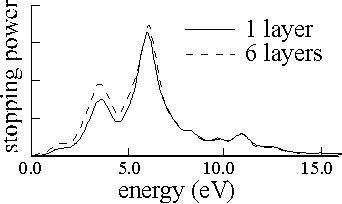
and
The dominant mechanism for the energy loss in this system is the phenomenon
of dielectric energy loss or plasmon loss. For aluminium, the bulk
plasmon loss occurs at an energy of 15eV. That is, a photon of energy 15eV will
excite an oscillation of the electrons within a large block of aluminium,
giving up all its energy in the process. It is also possible to lose energy to
the surface plasmon modes. These arise due to rearrangements of the
charge on the surface of the objects and they occur at different frequencies
to the bulk plasmons. For an isolated sphere, the surface plasmon losses occur
at discrete energies given by;

and ![]() is the bulk plasmon energy. Thus for aluminium, the first surface
plasmon mode occurs when l=1 and is called the dipole surface
plasmon. It occurs at 8.67eV for aluminium.
is the bulk plasmon energy. Thus for aluminium, the first surface
plasmon mode occurs when l=1 and is called the dipole surface
plasmon. It occurs at 8.67eV for aluminium.
Other surface plasmons can arrise due to the coupling of spheres, when
they are close proximity. However, a theoretical calculation of these coupled
surface plasmons is very difficult. Recently, a theoretical calculation was
performed on a linear chain of spheres. Previous to that, only a pair of
spheres had been succesfully calculated for. In this figure we show the energy
loss curves which we calculated using out photonics code OPAL.

Note the very broad loss peaks, indictating a whole spectrum of loss modes extending to zero. The major peaks occur below the bulk plasmon energy and the first dipole surface plasmon energy. Furthermore, they cannot be described by the couplings of a pair or chain of spheres. Thus we conclude that the coupled surface plasmons are far more complicated and important to the energy loss than those predicted by simplistic theories.